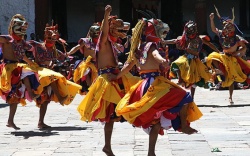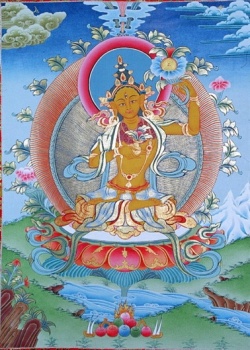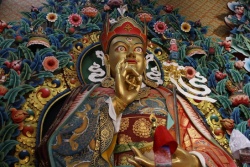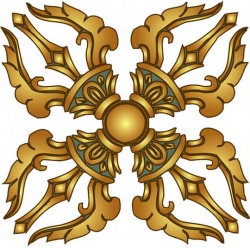What is a martial art?
A true martial art does not teach you how to fight, it teaches you how to fight back!
The martial arts are similar to a buffet. Everything is good to someone, but nothing is good to everyone. Some things people love, some things people hate. Some things people want all the time, some things people never want. Some things people want a lot of, some things they avoid. Sometimes people get too much of what they want, but they do not get enough of what they need. Some things that are good may not be good for you. So, just as in a buffet, in the martial arts, there are a lot of choices and you will never know what you might like until you sample everything.
There are hundreds of styles of martial arts and new ones are being "founded" every year. Men have been fighting hand-to-hand since Cain fought Able in the Garden of Eden. After all these millions of years of human fighting, do really think some "master" has suddenly discovered some new technique, some new pressure point, some new way to use your hands and feet in a fight, or some "lost" method of empty hand fighting. Think about how many bowling alleys there would be if "master" bowlers changed their stance, the way the held the ball, or the way the released the ball, and then started their own style of bowling. Some people just want to be noticed so they try to make something new and complicated out of something that is common and simple.
This topic attempts to give you an overview of many different martial art styles. I get e-mail all the time from martial artists who disagree with the descriptions of a particular art or its history. The purpose of TKDTutor.com is to inform, not to get involved in arguments about which art was first, which art is the best, or about whose version of a particular art's history is correct. If you want to know more about a specific martial art, do some intensive research on the art, but do not necessarily believe any one source.
Martial art term
The term martial art is used to describe a wide variety of physical activities. Nowadays, anything that involves some type of human fighting is called a martial art. The martial arts may be compared to auto racing. There are many types of auto racing, including NASCAR racing and Formula One racing.
NASCAR stock cars are basic, steel cars with massive engines. They are simple machines that compete by using brute force. The cars are tough and the drivers are tough. Drivers compete by banging their cars into each other and forcing their way to the front. They race on dry, oval tracks where they bump into each other and the retaining walls. At the end of a race, even the winning car is dented and ratty looking. Stock car drivers are usually "good old boys" with limited educations.
Formula One cars are complicated pieces of machinery, made from exotic materials with small technologically advanced engines. The cars are fragile, and, although not fragile, the drivers are refined. Drivers compete by using skill and finesse, rarely touching other cars. They race on winding road courses in any weather. At the end of a race, the cars, and drivers, are usually as pristine as when they began the race. Formula One drivers are usually "gentlemen" with higher educations.
Although NASCAR and Formula One are both ways to race automobiles, they are very different in their approaches to racing. One is basic, brutal, and in your face; the other is complicated, beautiful, and refined. The same may be said of the various systems of the martial arts.
Some martial arts are basic, brutal, in your face fighting systems whose only goal is to beat down the opponent. Other martial arts are complicated, beautiful, and refined fighting arts whose goal is the perfection of human character. Some martial arts, such as Brazilian Jujitsu or Mixed Martial Arts, claim to be the real deal, the best way to beat any opponent. They seek fights and feel fulfilled when they are in a fight, whether they win or not. They train to bang it out with opponents and see who is left standing at the end. Other martial arts are just that, they are martial ARTS. They are a way of life. They train to achieve perfection in fighting skills. They have the skills need to win in an actual fight but they have the philosophy that, if an actual fight occurs, you have failed in your art.
Combat skills vs. martial art skills
Although practically all ways of fighting are grouped under the term "martial arts," they are actually two major types of skills involved and thus, two separate entities: combat skills and martial art skills. Combat skills are skills that are used almost exclusively for real fighting, self-defense situations. Combat skills have been practiced for thousands of years. The first biblical account of combat training is recorded in Genesis 14:14. "When Abram heard that his kinsman had been taken captive, he led forth his trained men, born in his house, three hundred and eighteen of them, and went in pursuit as far as Dan."
Combat skills may be learned rather quickly and do not require much physical ability. They do not require much mental training other than the thought processes needed to be able to execute ruthless, deadly techniques upon another human being. Military personnel and law enforcement personnel learn hand-to-hand combat skills in a few short weeks in boot camp, and most never train in the techniques again even though they are may use them regularly in the field.
Martial arts are effective in, and may be used in, real fighting situations, but they involve much more than just fighting. Sometimes extraordinary physical abilities are required and intense mental control is always required. Martial artists learn core fighting skills and become proficient in them, but they go far beyond mere proficiency and strive for perfection of advanced martial art techniques. This is what separates the martial arts from the purely combative arts. Martial artists train in physical and mental fighting skills, but they also strive for perfection of human character.
Students may become proficient in a combat skill, such as a stomp to the instep or an uppercut palm under the chin, in a few days. However, once they are proficient at a skill, there is little more they may do to improve the skill. Therefore, even if they continue to train for years, they will stay proficient at the skill but they will learn or develop little else. People tend to get bored when they are not challenged or when they are not learning anything new. This is even more evident in today's society where we are bombarded with information daily. Nowadays, people need constant stimulus or they get bored. The martial arts demand precision of technique and movement, and being able to perform techniques with precision at testings and competitions. Since there is always room for improvement, students are never satisfied with their performance. If they ever do become satisfied, there is always a new advanced technique to challenge them. If not challenged by others, students will challenge themselves to reach perfection.
Martial art as an art
As people of action rather than students of words, many martial artists may not have thought much about what the word "art" in "martial art" really means. The term originated in ancient Greece. Socrates, the wisest of the Greeks, maintained that something is an "art" when it has "the greatest good of the soul or body in view." Substitute the words "character" and "personality" for "soul," and you have the meaning of a martial "art": "the study of war designed to build character and improve personality." The martial arts do not just build better fighters; they build better people.
The term martial arts, though once aptly defined as "methods of violence and the control of that violence," literally means "military skills" and it encompasses all the individual fighting methods. Martial arts were initially created for combat. Combat may occur in different forms: it may occur in war, during law enforcement duties, or even during personal self-defense. However, the martial arts evolved from just being fighting methods into becoming a way of life for their practitioners. Most people go through their entire lives without ever having to defend themselves physically; so, if self-defense were the only reason for learning a martial art, the time and effort would be a waste of time, effort, and money. Martial arts are used preserve life, through their use in self-defense, defense of others, or defense of country. Martial arts build character by teaching respect, honor, courtesy, integrity, perseverance, courage, and a sense of community.
Martial arts to not teach violence nor do they preach "thou shalt not" enter into violence. Instead, they recognize that violence exists, and must be dealt with on a daily basis in one way or another. Martial arts teach how to protect yourself against violence and how to control violence, but they also teach how to use violence when appropriate. They make dealing with violence a way of life. Many things may be considered "martial" in nature, such as firearms, knives, swords, and bombs, but the use of these things does not require one to dedicate his or her live to it, although it is possible to do so, as has been done with some forms of sword fighting. Likewise, one who is proficient in empty hand fighting does not have to dedicate his or her live to it; street fighters are proficient fighters but they do train to control violence, they merely training to inflict it. Martial artists consider their methods of fighting to be a part of their lives and they train to integrate their arts into their lives.
A desire for heightened enlightenment is often what attracts people to the martial arts. While it is true that students usually join a martial arts school to become physically fit and to be able to defend themselves, they often want something more than that as well. They want to bring some dignity and honor back into their lives, and they believe the martial arts offer such qualities. And they are right; the martial arts do offer these things, provided the instructors retain a respect for tradition and do not restrict their teaching to only fighting techniques.
The marital aspect of the martial arts pertains to fighting and violence, while the art aspect pertains to peace and calm. The two aspects combine to form the way, a separate aspect that unites the martial and the art so the violence may be controlled. Boxing is a method of fighting but there is no art, and no way, so there is no control over the violence. Boxers live for the violence, it becomes a major part of their lives, and many lack control of it. The same holds true for wrestling and modern mixed martial arts. In the classical, traditional martial arts, the way develops morality and a sense of inner being that allows practitioners to control their own violence and the violence of others around them. Without the way, there is no control over the violence.
Conclusions
The differences between combat skills and martial art skills may be compared to the differences between listening to a band in concert and listening to the band from a recording using headphone. When listening to the band using the headphones while sitting in your recliner, all extraneous sounds are blocked and you hear the nuisances of the music. You hear picks scrapping the strings of a guitar and you hear the fingernails of the pianist tapping on the keys. You may appreciate the music and appreciate how well the musicians perform. You hear the music of the band in its purest form, but only after it has been modified by numerous sound technicians. After listening to the music, you feel satisfied and, if you want to feel satisfied again, you just put on the headphones and play the music again.
When listening to the band in concert, you are immersed in the music. You not only hear the sound, you feel the sound over your entire body. You are jostled by the crowd; you hear them and feel their emotions. You in the mist of the action, experiencing the music of the band in its rawest form, you hear all the mistakes and off-key notes but you "feel" the music. After a concert, you feel alive and fulfilled, but the only way to achieve the feeling again is to attend another concert.
Martial art skills are satisfying and the satisfaction may be attained from merely performing the skills. Martial arts seek perfection of movement and, once satisfaction is attained, the movements that lead to the satisfaction may be easily replicated.
Combat skills are fulfilling, but to feel fulfilled, fighters must fight and they usually they must win. Perfection is neither sought not desired, winning is the goal. Each fight is different and cannot be replicated. One fight may be a good experience, the next bad. Fighters are addicts, they are only satisfied with they get their "fix."
A martial art is a way of life that may be used for self-defense. Easily 95% of the people in the United States will never be in situation where they are forced to defend themselves, so, if they spend their entire lives training to use their martial arts in a fight, they will be wasting their time. However, if they spend their entire lives training in their martial arts to improve their lives, then all the work will be worth it, even if they never have to defend themselves. People, who train in a martial art to fight, are disappointed if they do not get to fight. People who train in the "way" or the "do" of a martial art are disappointed when they must fight.
Martial arts are not something one does occasionally for self-defense or to improve physical fitness, rather, they are a way of living ones life in a way that enriches its enjoyment. This is the true secret of the martial arts.





